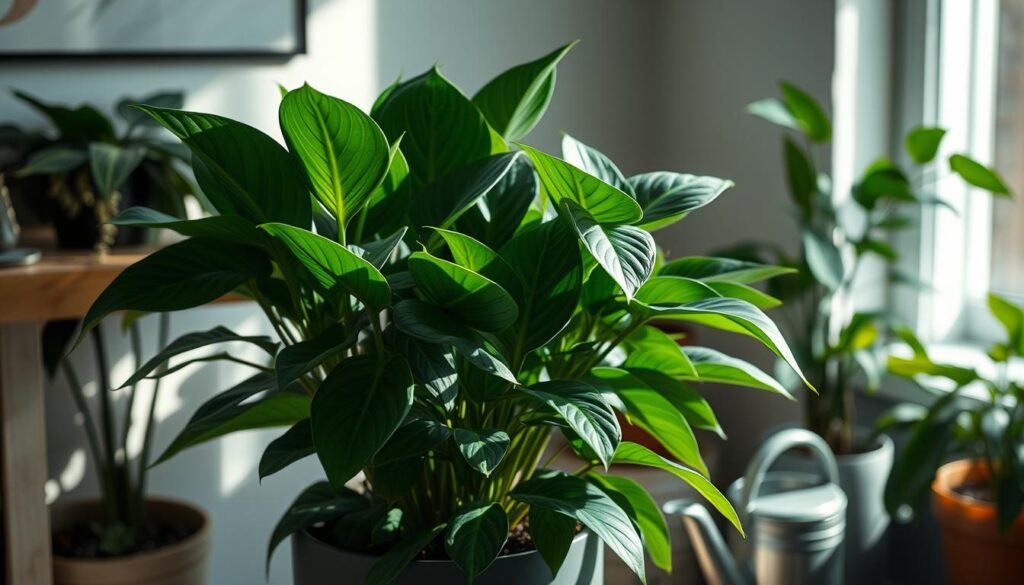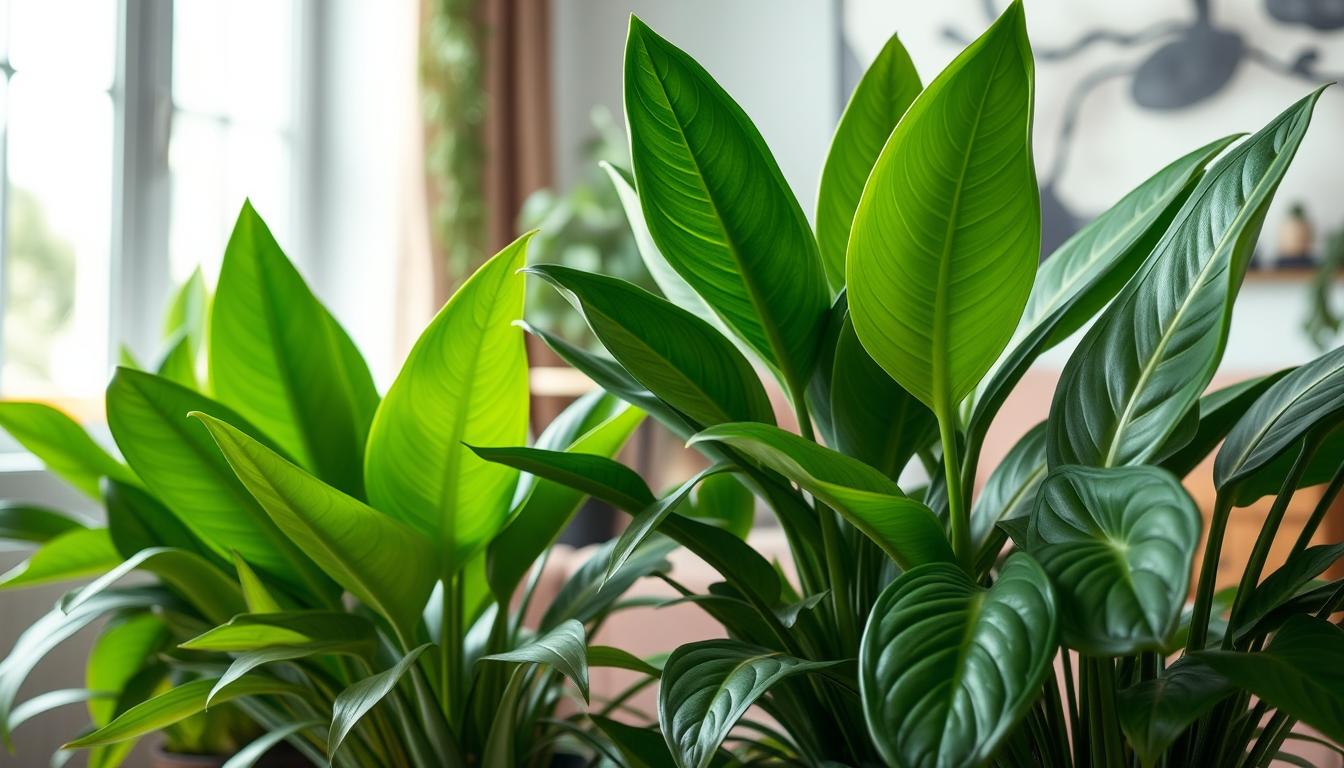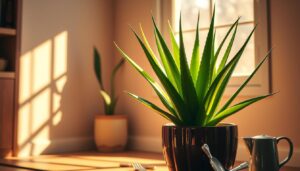As a beginner in the world of indoor gardening, finding the right plant can be a daunting task. That’s why many people turn to low-maintenance houseplants that are easy to care for and can thrive in a variety of conditions. The ZZ Plant is one such plant, known for its hardy nature and ability to survive in low-light conditions, making it a great choice for those new to ZZ Plant care.
With its ability to purify the air and add a touch of green to any room, the ZZ Plant has become a popular choice for many indoor gardeners. As a hardy indoor plant, it can tolerate a range of temperatures and humidity levels, making it perfect for those who tend to forget to water their plants from time to time. By following proper ZZ Plant care techniques, you can enjoy the many benefits of this low-maintenance houseplant.
Key Takeaways
- The ZZ Plant is a low-maintenance houseplant that can thrive in low-light conditions.
- It is a hardy indoor plant that can tolerate a range of temperatures and humidity levels.
- Proper ZZ Plant care involves infrequent watering and fertilization.
- The ZZ Plant is a great choice for beginners due to its ability to survive with minimal care.
- It can help purify the air and add a touch of green to any room.
- By following proper care techniques, you can enjoy the many benefits of this hardy indoor plant.
- ZZ Plant care is easy to learn and can be a great way to get started with indoor gardening.
Introduction to the ZZ Plant
The ZZ Plant, also known as Zamioculcas zamiifolia, is a low-maintenance houseplant that has gained popularity in recent years due to its ability to thrive in low-light conditions and infrequent watering. This makes it an ideal choice for busy individuals or those new to plant care. When it comes to ZZ Plant indoor care, it’s essential to understand the plant’s characteristics and needs.
One of the key factors to consider for ZZ Plant indoor care is the Zamioculcas zamiifolia light requirements. This plant can tolerate a range of lighting conditions, from low to bright indirect light, making it a versatile option for various spaces. In terms of its appearance, the ZZ Plant has glossy, dark green leaves that are waxy to the touch, adding a touch of elegance to any room.
Overview of the ZZ Plant’s Characteristics
The ZZ Plant is a compact, slow-growing plant that typically reaches a height of 2-3 feet. Its growth habits are relatively straightforward, requiring minimal pruning and grooming. This, combined with its low-maintenance requirements, makes it an excellent choice for beginners.
Why It’s Ideal for Beginners
The ZZ Plant is forgiving and can survive with neglect, making it perfect for those new to plant care. Its ability to tolerate low light and infrequent watering means that even the most forgetful plant owners can keep it happy and healthy. With proper ZZ Plant indoor care and attention to Zamioculcas zamiifolia light requirements, this plant can thrive and provide a beautiful, low-maintenance addition to any indoor space.
| Characteristics | Description |
|---|---|
| Light Requirements | Low to bright indirect light |
| Watering | Infrequent, allowing soil to dry between waterings |
| Growth Habits | Compact, slow-growing, reaching 2-3 feet in height |
Ideal Growing Conditions for Your ZZ Plant
When it comes to creating an ideal environment for your ZZ Plant, it’s essential to consider the plant’s adaptability to various conditions. As one of the best plants for low-light conditions, the ZZ Plant can thrive in areas with limited natural light, making it perfect for indoor spaces. The ZZ Plant temperature tolerance is also noteworthy, as it can withstand a range of temperatures between 55-75°F (13-24°C).
To ensure optimal growth, it’s crucial to provide your ZZ Plant with the right amount of light. While it can tolerate low light, it will still benefit from some indirect sunlight. Placing your ZZ Plant near an east- or west-facing window is an excellent way to provide it with the necessary light without exposing it to direct sunlight.
Light Requirements for Optimal Growth
In terms of light requirements, the ZZ Plant is relatively flexible. It can grow well in low-light conditions, but it will also tolerate medium to bright indirect light. To give you a better idea, here are some general guidelines for lighting:
- Low light: 50-75 foot-candles (east- or west-facing windows)
- Medium light: 75-150 foot-candles (south-facing windows with sheer curtains)
- Bright light: 150-250 foot-candles (south-facing windows without curtains)
Preferred Temperature and Humidity Levels
The ZZ Plant prefers temperatures between 65-75°F (18-24°C) during the day and no lower than 55°F (13°C) at night. As for humidity, it can tolerate average humidity levels, but it will benefit from a slightly higher humidity, around 40-50%.
Soil Type and Drainage Considerations
When it comes to soil, the ZZ Plant prefers well-draining potting mix to prevent waterlogged soil. A mix specifically designed for tropical plants or cacti will work well. Avoid using regular potting soil, as it can retain too much water and cause root rot.
| Soil Type | Drainage |
|---|---|
| Tropical plant mix | Well-draining |
| Cacti mix | Well-draining |
| Regular potting soil | Poor drainage |
Watering Guidelines for ZZ Plants
When it comes to ZZ Plant watering frequency, it’s essential to remember that these Low-maintenance houseplants prefer infrequent watering. Overwatering can lead to root rot, while underwatering can cause the leaves to become dry and brittle.
How Often to Water Your ZZ Plant
A general rule of thumb is to water your ZZ Plant once a week during the spring and summer months, and once every 2-3 weeks during the fall and winter months. However, this may vary depending on the humidity and temperature of your environment.
Signs of Overwatering vs. Underwatering
It’s crucial to recognize the signs of overwatering and underwatering to adjust your ZZ Plant watering frequency accordingly. If the leaves become yellow or soft, it may be a sign of overwatering. On the other hand, if the leaves become dry and brittle, it may be a sign of underwatering.
https://www.youtube.com/watch?v=y7k8Ghu3K7o&pp=ygUJI3JlcGFpcnp6
Best Practices for Watering Techniques
To ensure your ZZ Plant receives the right amount of water, use a well-draining potting mix and avoid getting water on the leaves. You can also use a moisture meter to check the soil moisture levels. By following these guidelines, you can keep your ZZ Plant happy and healthy.
Fertilizing Your ZZ Plant
When it comes to ZZ Plant care, fertilizing is an essential step in promoting healthy growth and preventing nutrient deficiencies. As a hardy indoor plant, the ZZ Plant can thrive in a variety of conditions, but it will still benefit from regular fertilization. To determine when to fertilize, check your plant’s growth and look for signs such as yellowing leaves or slow growth.
A balanced, water-soluble fertilizer is recommended for ZZ Plants. You can fertilize your plant during the growing season, which typically takes place in the spring and summer months. Dilute the fertilizer to half the recommended strength to avoid burning the roots. It’s also important to note that ZZ Plants don’t require a lot of fertilizer, so start with a small amount and adjust as needed.
Signs Your ZZ Plant Needs Fertilization
- Yellowing or discolored leaves
- Slow or stunted growth
- Weak or brittle stems
By fertilizing your ZZ Plant regularly, you can help promote healthy growth and prevent common problems. Remember to choose a fertilizer that is specifically designed for indoor plants, and follow the instructions carefully to avoid over-fertilizing. With proper care and attention, your ZZ Plant will thrive and become a beautiful, low-maintenance addition to your home.
Repotting Your ZZ Plant
As a low-maintenance houseplant, the ZZ Plant is perfect for busy individuals who want to bring some greenery into their homes. When it comes to repotting, it’s essential to do it correctly to ensure your plant continues to thrive. Repotting is a crucial step in ZZ Plant propagation, as it provides the plant with fresh soil and a larger pot to accommodate its growth.
Before repotting, it’s vital to choose the right pot size and material. A pot that is too small can cause the soil to dry out quickly, while a pot that is too large can lead to waterlogged soil. Consider a pot that is only one to two sizes larger than the current one to prevent shocking the plant’s roots. You can also use a well-draining potting mix to prevent water from accumulating in the soil.
- Water the plant a day or two before repotting to make the soil easier to handle.
- Gently remove the plant from its pot, taking care not to damage the roots.
- Inspect the roots and trim any dead or damaged roots to prevent the spread of disease.
- Place the plant in its new pot, adding fresh potting mix around the roots.
By following these steps and choosing the right pot size and material, you can help your ZZ Plant continue to grow and thrive, making it a beautiful and low-maintenance addition to your home.
| Repotting Tips | Benefits |
|---|---|
| Repot in the spring or summer | Encourages new growth and helps the plant adapt to its new environment |
| Use a well-draining potting mix | Prevents waterlogged soil and reduces the risk of root rot |
| Handle the roots with care | Prevents damage to the roots and reduces the risk of shock |
Pruning and Grooming Your ZZ Plant
Pruning is an essential part of ZZ Plant care, as it helps maintain the plant’s shape and promotes healthy growth. By removing dead or damaged leaves, you can prevent the spread of disease and encourage new growth. For Plants for low-light conditions like the ZZ Plant, pruning is crucial to ensure they receive adequate light and air circulation.
When it comes to pruning your ZZ Plant, it’s essential to use the right techniques. ZZ Plant care guides often recommend using clean and sharp tools to prevent spreading diseases. You can start by removing any dead or damaged leaves, and then trim back any overgrown stems to maintain the plant’s shape.
- Providing support for the plant’s stems to prevent them from becoming leggy
- Removing any debris or dead leaves from the soil to prevent rot
- Pruning the plant regularly to maintain its shape and promote healthy growth
By following these tips and using the right pruning techniques, you can keep your ZZ Plant looking its best and ensure it continues to thrive in low-light conditions.
Common Pests and Diseases in ZZ Plants
When it comes to ZZ Plant indoor care, it’s essential to be aware of the common pests and diseases that can affect these hardy indoor plants. Regular monitoring of your plant’s health can help you identify potential issues early on, allowing you to take action quickly and prevent further damage.
Some common pests that can infest ZZ Plants include mealybugs, spider mites, and scale. These pests can cause damage to the plant’s leaves and stems, leading to discoloration and reduced growth. To treat pest problems, you can use organic solutions such as neem oil or insecticidal soap.
Identifying Common Pests
- Mealybugs: small, white, cottony patches on the leaves and stems
- Spider mites: fine webbing on the leaves and stems, yellowing or bronzing of the leaves
- Scale: small, brown or black bumps on the leaves and stems
Preventative Measures for Disease Control
To prevent diseases from affecting your ZZ Plant, make sure to provide good air circulation and avoid overwatering. You can also use a well-draining potting mix and avoid getting water on the leaves to prevent fungal diseases.
By following these tips and being mindful of the common pests and diseases that can affect ZZ Plants, you can help keep your hardy indoor plants healthy and thriving.
| Pest/Disease | Symptoms | Treatment |
|---|---|---|
| Mealybugs | White, cottony patches on leaves and stems | Neem oil or insecticidal soap |
| Spider mites | Fine webbing on leaves and stems, yellowing or bronzing of leaves | Neem oil or insecticidal soap |
| Scale | Small, brown or black bumps on leaves and stems | Neem oil or insecticidal soap |
Propagating Your ZZ Plant
ZZ Plant propagation is a great way to share plants with friends and create new plants for your home. As a low-maintenance houseplant, the ZZ Plant is perfect for beginners who want to try their hand at propagation. To get started, it’s essential to understand the various methods of propagation, including leaf cuttings and division.
One of the most popular methods of ZZ Plant propagation is through leaf cuttings. This involves cutting off a healthy leaf from the mother plant and placing it in water or potting mix. For more information on this process, you can visit ZZ Plant propagation guides to learn more about the best practices for propagating your ZZ Plant.
When it comes to ZZ Plant propagation, timing is everything. The best time to propagate your ZZ Plant is during the spring and summer months when the plant is actively growing. This increases the chances of successful propagation and helps to ensure that your new plants will thrive.
- Choose a healthy leaf or division from the mother plant
- Place the cutting in water or potting mix
- Provide the right conditions for growth, including light and temperature
- Wait for the new plant to develop roots and leaves
By following these steps and using the right techniques, you can successfully propagate your ZZ Plant and enjoy the benefits of having more low-maintenance houseplants in your home.
Addressing ZZ Plant Care Myths
When it comes to ZZ Plant care, there are several myths and misconceptions that can lead to confusion among plant owners. One of the most common myths is that ZZ Plants are toxic to humans and pets. However, this is not entirely true. While it is true that ZZ Plants contain toxic compounds, they are not typically harmful to humans or pets unless ingested in large quantities.
Another common myth surrounding ZZ Plant care is that they require a lot of light to thrive. In reality, ZZ Plants are Plants for low-light conditions and can do well in areas with limited natural light. This makes them a great option for rooms with minimal windows or for people who tend to forget to water their plants.
Here are some common myths and misconceptions about ZZ Plant care:
- Myth: ZZ Plants are high-maintenance and require frequent watering.
- Myth: ZZ Plants need direct sunlight to thrive.
- Myth: ZZ Plants are prone to pests and diseases.
In reality, ZZ Plant care is relatively simple and straightforward. By following a few basic tips, such as watering sparingly and providing indirect sunlight, you can keep your ZZ Plant happy and healthy. With proper care, ZZ Plants can thrive in a variety of conditions, making them a great option for anyone looking to add some greenery to their space.

By separating fact from fiction and understanding the truth about ZZ Plant care, you can provide your plant with the best possible care and enjoy its many benefits. Whether you’re a seasoned plant owner or just starting out, ZZ Plants are a great option for anyone looking to add some low-maintenance greenery to their space.
| Myth | Reality |
|---|---|
| ZZ Plants are toxic to humans and pets. | ZZ Plants contain toxic compounds, but are not typically harmful unless ingested in large quantities. |
| ZZ Plants require a lot of light to thrive. | ZZ Plants are Plants for low-light conditions and can do well in areas with limited natural light. |
Enhancing Your Indoor Space with ZZ Plants
ZZ Plants are a great addition to any home, providing a touch of natural beauty and freshness to your indoor space. With their unique, glossy leaves and low-maintenance requirements, they are perfect for busy individuals who want to bring some greenery into their lives. When it comes to ZZ Plant indoor care, it’s essential to consider the overall aesthetic you want to achieve in your home.
One of the benefits of having ZZ Plants in your home is their ability to purify the air and reduce stress. They are also known to be Hardy indoor plants, making them a great choice for those who tend to forget to water their plants from time to time. To complement your home décor with ZZ Plants, consider placing them in a corner or against a wall, where they can add a touch of elegance and sophistication.
Complementing Home Décor with ZZ Plants
ZZ Plants come in a variety of shapes and sizes, making them versatile and easy to incorporate into any home décor. You can place them on a shelf, in a hanging basket, or even on the floor, depending on the look you want to achieve. Their dark green leaves and sleek stems make them a great addition to any room, and they can help to create a sense of calm and serenity.
Benefits of Having ZZ Plants in Your Home
In addition to their aesthetic appeal, ZZ Plants have several benefits that make them a great choice for indoor spaces. They are known to be air-purifying, removing toxins and pollutants from the air and improving the overall air quality. They are also low-maintenance, requiring only occasional watering and fertilization. This makes them perfect for busy individuals who want to enjoy the benefits of having plants in their home without the hassle of constant care.
Additional Plants to Pair with ZZ Plants
To create a beautiful and thriving indoor garden, consider pairing your ZZ Plant with other low-maintenance plants, such as snake plants or spider plants. These plants are easy to care for and can help to create a lush, green atmosphere in your home. By combining different plants and textures, you can create a unique and visually appealing space that reflects your personal style and adds to the overall ambiance of your home.
Conclusion: Embracing Your ZZ Plant Journey
As we conclude our exploration of the resilient and low-maintenance ZZ Plant, it’s clear that this remarkable houseplant is a true gem for beginners and experienced gardeners alike. With its ability to thrive in a wide range of conditions, the ZZ Plant is an excellent choice for those seeking a hassle-free addition to their indoor spaces.
Recap of Key Care Tips
Remember, the key to maintaining a healthy ZZ Plant lies in providing the right amount of light, water, and fertilizer. By following the guidelines outlined in this article, you can ensure your ZZ Plant continues to flourish and enhance the ambiance of your home.
Encouragement for New ZZ Plant Owners
If you’re a new ZZ Plant owner, take heart in the knowledge that these plants are remarkably forgiving. With a little patience and the proper care, your ZZ Plant will reward you with its lush, glossy foliage and air-purifying benefits. Embrace the journey of nurturing this resilient houseplant.
Resources for Further Learning on ZZ Plant Care
For those interested in delving deeper into the world of ZZ Plant care, there are numerous resources available. Explore online forums, social media groups, and reputable gardening websites to connect with fellow plant enthusiasts and learn from their experiences. With the right information and a touch of green-thumbed dedication, you’ll be well on your way to creating a thriving ZZ Plant oasis in your home.





Pingback: "What Are the Best Low Light Indoor Plants? Discover 10 Perfect Varieties. - Trusted House Plant Guide
Pingback: The Ultimate Beginner's Guide to the Most Wanted Indoor Plant for 2025 - Trusted House Plant Guide